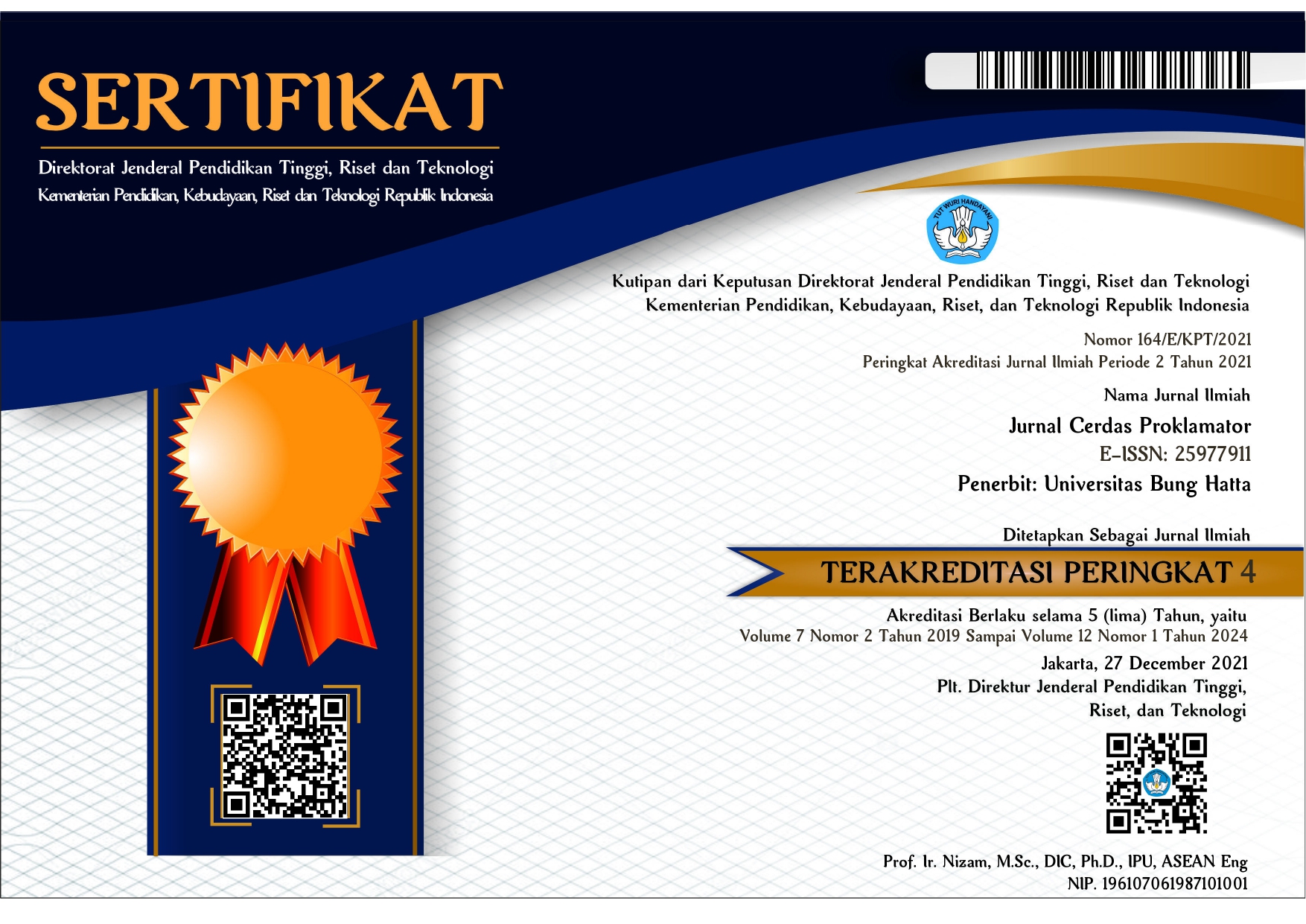PENERAPAN MODEL PEMBELAJARAN PBL (PROBLEM BASED LEARNING) UNTUK MENINGKATKAN KEMAMPUAN PEMECAHAN MASALAH SISWA DI KELAS V SEKOLAH DASAR
DOI:
https://doi.org/10.37301/jcp.v9i1.74Keywords:
PBL learning model (Problem Based Learning), Keterampilan pemecahan masalah.Abstract
Abstrac. Keterampilan pemecahan masalah merupakan salah satu keterampilan penting yang harus dimiliki oleh siswa di abad ke-21. Keterampilan pemecahan masalah siswa dapat dilatih dalam proses pembelajaran. Penelitian ini bertujuan untuk mengetahui keterampilan pemecahan masalah siswa pada pembelajaran IPA. Metode penelitian menggunakan penelitian deskriptif dengan pendekatan kuantitatif. Subyek penelitian ini adalah 30 siswa kelas V SD Al-Azhar 32 Padang yang dipilih dengan probability sampling dengan teknik proportionale stratified random sampling. Teknik pengumpulan data menggunakan bentuk test dan non test berupa soal pilihan ganda dan pedoman wawancara. Hasil penelitian menunjukkan bahwa: (1) tingkat keterampilan pemecahan masalah siswa SD Al-Azhar 32 Padang berada pada kategori sedang, yang dapat dilihat dari hasil pengerjaan siswa dalam tes keterampilan pemecahan masalah pada pembelajaran IPA (2) Faktor- faktor yang berpengaruh pada proses pemecahan masalah siswa dalam pembelajaran secara global adalah: (a) ketelitian siswa dalam mengerjakan soal, (b) kebiasaan siswa dalam mengerjakan soal keterampilan pemecahan masalah dan (c) penguasaan konsep topik dari siswa. Hasil siklus I menunjukan nilai rata-rata ketercapaian siswa adalah sebesar 33,26 % sedangkan pada siklus II yaitu sebesar 76,38 % terjadi peningatan sebesar 43,12%.
References
Charles, R. I., & Lester, F. K., Jr. (1982). Teaching Problem Solving: What, Why, & How. Palo Alto, CA: Seymour
Blum, W., & Niss, M. (1991). Applied mathematical problem solving, modelling, applications, and links to subjects-state, trends and issues in mathematics instruction. Educational Studies in Mathematics, 22(1), 37-68.
Huitt, W. (1992). Problem solving and decision making: Consideration of individual differences using the Myers-Briggs Type Indicator. Journal of Psychological Type, 24, 33-44.
Byu, T., & Lee, G. (2014). Why Students Still Can’t Solve Physics Problems after Solving over 2000 Problems. American Journal of Physics, 82, 906-913.https://doi.org/10.1119/1.4881606
Joyce,B.,Weil,M.& Calhoun, B. (2009) Models of teaching 8th ed.( teaching models, translators ahmad fawaid dan ateilla mirza) yogyakarta : pustaka pelajar
Abdullah.,& Sani, R. (2010). Scientific learning for the curriculum 2013. Jakarta: Bumi Aksara
Eggen., Paul, DK. (2012). Learning Strategies and Models. Jakarta: PT Indeks
Hmelo-Silver,C.E.(2004). Problem-based learning:What and how dostudents learn?. Journal: Educational Psychology Review, 16(3) hlm.235-266.
Runco.,& Chand (1995) Runco, M.A. and Chand, I. (1995) Cognition and Creativity. Educational Psychology Review, 7, 243-267
Piaget, J. (1982). Cognitive Development in Children: Development in Learning. Journal of Research in Science Teaching, Vol. 2, 176-186.
Barrows, H. S., & Tamblyn, R. M. (1980). Problem-Based Learning: An Approach to Medical Education. New York: Springer.
Barrows, H. S., & Tamblyn, R. M. (1980). Problem-based learning: An approach to medical education. New York: Springer. based Learning: Irish Case Studies and International Perspectives. AISHE READINGS.
Mark al Albanese & Susan,M (1993) Problem-based learning: A review of literature on its outcomes and implementation issues.academic medicine. University of Wisconsin–Madison
Tan, O.S., Chye, S. & Teo, C.T. (2009). Problem Based Learning and creativity: A review of the literature. In: O.S. Tan (Ed.), Problem Based Learning and Creativity (pp.15-38). Singapore: Engage Learning.
Arends, R. (2008). Learning to Teach. Jogjakarta: Pustaka Pelajar
Bruner, J.S. (1957). On Perceptual Readiness. Psychological Review, April 1957. Vol. 64 No. 2. Hal. 123-149. Harvard University.
Solso.,&Robert. Dkk. (2008).Cognitive Psychology Eighth Edition. Jakarta:Erlangga.
Pierce,B.(2002).”Genetics: A Conceptual Approach”. New Work: W. H. Freeman Ltd.
Tobin, K. G. & Capie, W. (1981). Patterns of Reasoning: Probabilistic Reasoning. Paper Presented at Annual Meeting of The National Association for Research in Science Teaching, New York.
Jonnasen, D.H. & Serrano, J.H. 2002. Case-Based Reasoning and Instructional Design: Using Stories to Support Problem Solving; ETR&D: Vol. 50 (2) pp 65 – 77.
Ge, Xun & Land. S.M., 2004. A Conceptual Framework for Scaffolding Ill-Structured Problem solving Processess Using Question Prompts and Peer Interactions; ETR&D: Vol. 52 (2) pp 5-22.
Frederiksen, N. 1984. Implications of Cognitive Theory for Instruction in Problem Solving; Review of Educational Research; Vol. 54 (3): 363-407.
Lampert. M, 1990. When the Problem Is Not the Question and the Solution Is Not Answer: Mathematical Knowing and Teaching. American Educational Research Journal ; Spring. Vol. 27 (1), pp 29 –63.
Hokanson, B. & Hooper, S. 2004. Level of Teaching: A Taxonomy for Instructional Design. Educational Technology; November-December.
Henk g. Schmidt, sofie m. M. Loyens, tamara van gog & fred paas (2007) Problem-Based Learning is Compatible with Human Cognitive Architecture: Commentary on Kirschner, Sweller, and, Educational Psychologist, 42:2, 91-97, DOI: 10.1080/00461520701263350
Marshall, S. P. (2010). Re-imagining special-ized STEM academies: Igniting and nur-turing decidedly different minds, by de-sign. Roeper Review, 32, 48-60
Mustaffa, N. B., Ismail, Z. B., Tasir, Z. B., & Mohamad Said, M. N. H. B. (2014). Problem-Based Learning (PBL) in Mathematics: a Meta Analysis. In International Education Postgraduate Seminar 2014, p301.
Wang, G. S. (2012). PBL and critical thinking. In C. H. Yang (Eds), PBL Teaching practice - in National Yilan University Experience and Reflection: 44-53.Yilan County: National Yilan University.
Downloads
Published
Issue
Section
License
Copy right in each article belong to the authors.
1. The author acknowledges that the Journal Cerdas Proklamator as a publisher who publishes for the first time with the
Creative Commons Attribution 4.0 International License.
2. The Author can enter the writing separately, manage the non exclusive distribution of manuscripts that have been published in this journal into the other versions (eg sent to the repository of the author's institution, publication in book, etc), by acknowledge that the manuscript was first published in the Jurnal Cerdas Proklamator.

























